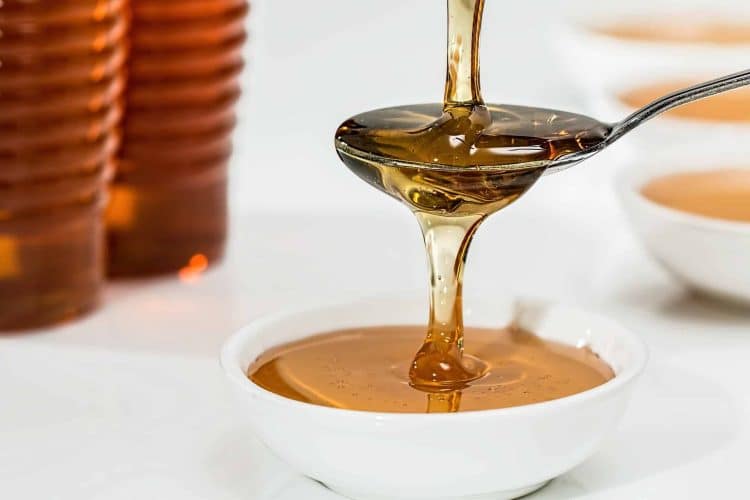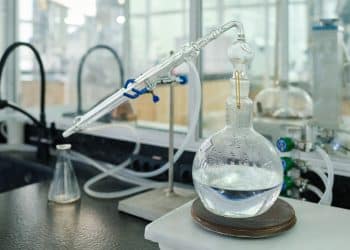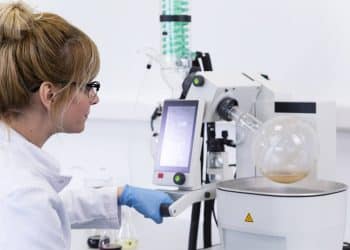Demand for light-colored extracts has inspired some Cannabis sativa extractors to use activated charcoal and silica to ‘clean-up’ extracts. These materials are capable of drawing unwanted compounds out of extracts, particularly pigments. This process is colloquially referred to as polishing.
Activated charcoal (or activated carbon) is composed of molecule-sized porosity (holes or voids) and carbon atoms. The carbon atoms generate electrostatic attraction in the voids, leading to adsorption of other molecules. [1] Silica gel functions similarly; high porosity between silicon dioxide molecules lends adsorbent and desiccant properties.
Activated charcoal and silica gel have demonstrated commercial viability for numerous extraction clean-up applications. For example, silica gel is used to remove polar molecules from groundwater samples at petroleum release sites, allowing for a measure of petroleum hydrocarbons. [2] Activated charcoal is an effective sorbent for tomato pigments, improving pesticide recovery and testing. [3] Both compounds are efficacious in removing undesirable compounds (e.g., acetaldehyde) from agricultural distillates and subsequent alcoholic beverages. [4]
In a 2019 study published in Scientific Reports, researchers used a mixture of activated charcoal and silica gel at a 7:5 ratio. They placed the mixture on a layer of sodium sulfate and glass wool to ‘clean up’ the filtered extract of spinach. The washing procedure effectively removed matrix impurities to allow precise recording of pesticide residue. [5]
Carbon filters are commonly used after ethanol extraction of cannabis to remove chlorophyll. ErtelAlsop is one company that vends carbon and silica filtration equipment for cannabis extraction. However, if the temperature is low enough, ethanol will not extract chlorophyll, negating the need for such filtration.
More commonly, small-scale extractors use polishing techniques to remediate bad batches. Polishing has the potential to convert putrid green swamp water into odorless, gold liquid, but it is imperative to remember that activated carbon and silica can adsorb cannabinoids, terpenes, and oil. Based on anecdotal evidence, the process may reduce yield by over 15%. One extraction/distillation company points out that the filter media may degrade THC and overall potency, especially if microscopic sediments remain in the extract (they recommend a sub-micron filter). If performed properly, however, potency may increase relative to reduced yield.
Unfortunately, there are no reliable standards for how much of each component to use at given temperatures/times. The published science of these clean-up agents does not extend to cannabis extraction (yet). Experimentation is absolutely required.
Even so, there are guidelines to facilitate a successful clean up. Choose reliable products, and rinse the clean-up agents with ethanol prior to use. Carbon Chemistry vends lab-grade activated carbon and silica in solid form.
Begin with small, measured amounts of extract. Quantify the carbon, silica, temperature, and time. Measure potency before and after each trial. Record results and proceed in an iterative fashion. Once the desired result has been achieved on a small scale, use the quantified ratios of materials to expand the clean up.
Polishing cannabis extracts with activated charcoal and silica can be a powerful way to lighten color, odor, and taste. However, dark-colored extract does not always indicate poor quality. Consider if polishing is required. Then adopt a cautious, experimental procedure to avoid spoiling an entire batch.
References
- Marsh, Harry, and Reinoso Francisco Rodríguez. “Introduction to the Scope of the Text,” Activated Carbon. Elsevier Science Ltd, 2006. Google Books.
- Zemo, Dawn A., et al. “Comparison of Shake and Column Silica Gel Cleanup Methods for Groundwater Extracts to Be Analyzed for TPHd/DRO.” Groundwater Monitoring & Remediation, vol. 33, no. 4, 2013, pp. 108–112., doi:10.1111/gwmr.12032. Journal Impact Factor = 1.192, Times Cited = 3 (ResearchGate)
- Kaipper, Beatriz I. A., et al. “Use of Activated Charcoal in a Solid-Phase Extraction Technique for Analysis of Pesticide Residues in Tomatoes.” Journal of the Brazilian Chemical Society, vol. 12, no. 4, 2001, pp. 514–518., doi:10.1590/s0103-50532001000400012. Journal Impact Factor = 1.444, Times Cited = 16 (ResearchGate)
- Balcerek, Maria, et al. “Treatment with Activated Carbon and Other Adsorbents as an Effective Method for Removal of Volatile Compounds in Agricultural Distillates.” Food Additives & Contaminants: Part A, 2017, doi:10.1080/19440049.2017.1284347. Journal Impact Factor = 1.03, Times Cited = 2 (PubMed)
- Amir, Rai Muhammad, et al. “Assessing and Reporting Household Chemicals as a Novel Tool to Mitigate Pesticide Residues in Spinach (Spinacia oleracea).” Scientific Reports, vol. 9, no. 1, 2019, doi:10.1038/s41598-018-37936-2. Journal Impact Factor = 4.525












